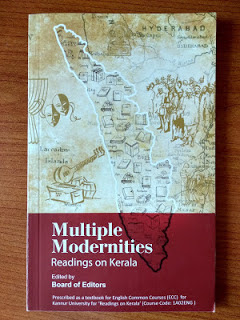Curing Caste by Sahodaran Ayyappan: READINGS ON KERALA
Curing Caste
Sahodaran Ayyappan
Paragraph questions:
1.
Explain Sahodaran Ayyappan’s coinage “Caste
Disease”.
“Curing
Caste” is a poem written by Sahodaran Ayyappan, translated by Dr Ajay Sekher
and published in the book Sahodaran Ayyappan: Towards a Democratic Future. Sahodaran Ayyappan uses the phrase “Caste Disease”
to denote the practice of discrimination based on caste that existed in Kerala
society. He uses medical terms to symbolically phrase the harsh realities of
the caste-based social order prevalent during his time. Sahodaran Ayyappan
suggests two cures for the caste disease: one is applied from the outside and
the other is from the inside. The cures that are only applied externally leave
the real causes of the caste problem unsolved. External solutions are short-lived.
Without being eradicated, the caste disease could cause further damage in the
psyche of the individual as well as the in the function of the society similar
to a disease that is left unhealed. According to Ayyappan, the only way to heal
caste disease is to apply a cure from the inside.
2.
How do some politicians exploit caste disease?
Sahodaran Ayyappan is a social reformer,
revolutionary, poet, rationalist, administrator, and legislator. His
contributions in ushering progressive thought in the Kerala polity are
significant. In his poem “Curing Caste”, Ayyappan uses a medicinal simile to
articulate his anti-caste views. According to Ayyappan, caste can be compared
to a disease that has two forms of cures; one from the inside and the other
from the outside. The medicines taken externally can have an only transitory
impact on the disease. The caste disease thus left unhealed, could retreat into
the inside and wreak havoc inwardly in the individual’s psyche. Ayyappan
invokes the perspective of ancient sages to demonstrate his point. He says that
hate, gossip, and nationalist rhetoric are symptoms of caste existing dormant
in the collective psyche of society. Individuals who nurture caste- bias are
prone to become successful as politicians who rally masses in the name of caste
and hate-speech. Politicians exploit caste-disease to gather support and secure
power.
3.
Explain the lines “Those who cure caste without trying
to alleviate it/ Are trying to cool off without extinguishing the fire.”
Sahodaran Ayyappan is a social reformer,
revolutionary, poet, rationalist, administrator, and legislator. His
contributions in ushering progressive thought in the Kerala polity are
significant. In his poem “Curing Caste”, Ayyappan uses a medical simile to
articulate his anti-caste views. According to Ayyappan, caste can be compared
to a disease that has two forms of cures; one from the inside and the other
from the outside. The medicines taken externally can have an only transitory
impact on the disease. External solutions are short-lived. Without being
eradicated, the caste disease could cause further damage in the psyche of the
individual as well as the in the function of the society similar to a disease
that is left unhealed. Ayyappan suggests that without minimising the intensity
of the caste problem, no cure can have its desired impact. Without
extinguishing the raging fire of caste-based discrimination, none of the solutions
would work properly. It would be similar to cooling off without extinguishing
the fire, a meaningless as well as hopeless act.
4.
What are the benefits of curing caste?
&
5.
What, according to Ayyappan, are the essential
elements for gaining full human potential?
Sahodaran Ayyappan is a social reformer,
revolutionary, poet, rationalist, administrator, and legislator. His
contributions in ushering progressive thought in the Kerala polity are
significant. In his poem “Curing Caste” Ayyappan sees caste as a disease and
prescribes remedies to heal it. According to Ayyappan if the individual is
healed of the caste disease, he or she will be able to see the true nature of
human beings. Those individuals become healthy and normal. The poet compares
the individual freed of the caste disease with those who recuperate from a
major illness. He states that the flaws and virtues of a human being can be
identified only by those who can overcome the caste disease. The essential
elements for gaining full human potential are not just the use of human
intelligence or learning new skills. It is, on the other hand, getting rid of
the caste-bias.
REF: Multiple Modernities, edited by Board of Editors, Kannur University,
Cohin: Hornbill Publishing House, 2019. Print.
NEXT: ESSAY QUESTIONS
NEXT: ESSAY QUESTIONS







Comments